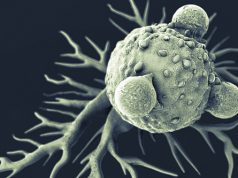Cytokine Release Syndrome (CRS) is one of the most common, but worrisome, serious side effects of CAR T-cell therapy. How does it occur? After engineering, the CAR T-cells are reinfused back into the patient which leads to the release of cytokines (chemical messengers) like interleukin 6 (IL-6) and IL-15 into the bloodstream. The cytokines aid the CAR T-cells to begin tumor attack.
Due to cytokine release, very high fevers, sharp drops in blood pressure, tachycardia, and low oxygenation can occur, usually in the first week. Neurotoxicity such as delirium, confusion, and seizure may appear, as well. Patients with more extensive disease may experience more serious events. Ironically, CRS is an effect of T-cell activiation which denotes a positive repsonse to therapy. In the ZUMA-1 study of agressive B-cell non-Hodgkin lymphoma, CRS and neurotoxicity occurred in roughly 13% and 28% of patients, respectively.
CRS can be life-threatening, but is reversible in most patients. Administration of tocilizumab (Actmera), an agent that blocks IL-6, has been used to manage cases of CRS, and researchers state that it does not appear to interfere with the CAR T cells’ activity or proliferation. Etanercept (Enbrel), which blocks tumor necrosis factor, has also been used.





